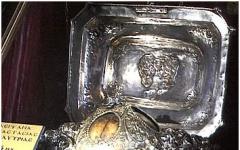Today, the manufacturer installs 2 types of boxes on the Lada Vesta: mechanical and the Lada Vesta box - AMT robot. The AvtoVAZ press service constantly notes that the company plans to manufacture its own completely automatic boxes, but the conversations don’t go beyond assurances, specific dates does not appear in the promises, so it is unknown when Russian car enthusiasts will wait for this innovation.
Manual transmissions
Until September 2016 The Lada Vesta was equipped with manual gearboxes manufactured by Renault, which, in order to optimize and reduce the cost, were replaced with gearboxes Russian production. The new gearboxes, marked with the VAZ-21807 index, have become a reinforced version of the traditional base VAZ-2180 gearbox, equipped with a cable drive shift mechanism. Modification 21807 is designed for higher torque than 2180 and is much quieter than the original box.
With the change of box, the gear ratio of the main pair was slightly increased from 3.87 to 3.94. Vesta also became more dynamic according to the passport: the acceleration time to 100 km/h decreased from 11.2 s to 10.2 s and increased maximum speed from 175km/h to 188km/h. Although, as a minus, it can be noted that fuel consumption has increased slightly: from 6.9 to 7.5 l/100 km in the combined cycle.
Today, the production of cars with Renault gearboxes has largely ceased, although, of course, they can be found in sufficient quantities among used models. It is possible to identify the gearbox model by the VIN number of the car: if it contains the code GFL13, then it is a Renault manual gearbox, the code is GFL11 - this is a VAZ “mechanics”.
Versions with the first robot are coded GFL12. However, for example Lada Vesta The SV cross is equipped with 2 mechanical transmissions to choose from: the first of which is domestically produced, and the second is French. In the second case, the car is equipped with a French 5-speed manual JR5 from Renault (the main pair is 4.212).
Read also

Automatic boxes
The first automated gearbox, VAZ’s own AMT design, appeared in the fall of 2014. It is designed on the basis of a 5-speed manual gearbox and is supplemented electronic unit controls and ZF actuators.

In February 2018 New AMT 2.0 robots also appeared, replacing the first AMT development. The AMT 2.0 robotic gearbox is installed only on 1.8 engines, however, it is possible to reflash cars of previous releases, including those with a 1.6 engine. To do this, you need to contact the dealership. To activate the Crawl mode on earlier cars, it is necessary to reflash the engine ECM and AMT. No structural changes are required to the car.

The main advantage of the modernized robots is the appearance of 2 modes - creeping and winter, as well as a reduction in the time of sequential gear shifting from 1st to 2nd, then to 3rd. Switching intervals have been reduced by as much as 30% thanks to the optimization of the servo drive activation algorithm, regardless of engine speed. The creep mode increases the convenience of movement in dense traffic flow (in traffic jams).

As for the creep mode, it is borrowed from the standard machine. When the gear selector is in positions A, M, R, the car moves forward or backward without fuel supply until the brake is pressed, the handbrake is raised, and the door is opened. The driving speed can reach 15 km/h depending on the gear selection. In first gear it is 7–8 km/h, in second up to 14–15 km/h, and when moving backwards it is 5–6 km/h.
There is no separate button for winter mode. It will help you start on a slippery surface from second gear. To do this, just after starting the engine, press the brake and select gear M2 with the gearbox selector.
Variable speed drive
And, of course, fans of the Tolyatti auto industry are looking forward to the appearance of the promised CVT in 2019. According to preliminary information, a variator with an imitation of 7 steps will first be offered in combination with the Nissan 1.6L HR16 engine, since we are talking about the Jatco JF015E transmission, which is designed for torque up to 160 Nm. It is quite possible that in the future the CVT continuously variable transmission will be gradually adapted to its own 1.8L engine.
The advantages of a CVT over an AMT are obvious. This is, first of all, the convenience of speed control. Cars with CVT pick up speed especially smoothly, without jerks or dips. They have a smoother ride and more dynamic acceleration than AT cars. The CVT is significantly quieter and more economical than classic torque converter transmissions.
Conclusion
It should be noted that transmission optimization is a constant process at AvtoVAZ. However, all this information is unofficial and there is no confirmation of it. Although an undoubted fact remains the growth in sales of the Lada Vesta in 2018. In the first four months, the sales volume of the entire Lada increased by more than a quarter - to 110,000 cars. Demand for Lada Vesta increased by almost 25.5% compared to last year.
When choosing a gearbox version for the Lada Vesta, each driver usually starts from own experience. Professionals will not exchange a manual transmission for anything, in which the shift speed depends solely on the speed of the hands, and in a big city, AMT 2.0 with a creeping mode will be useful. Vesta does not yet have a smart and full-fledged automatic machine, but one can immediately expect that the price will become its important drawback.
Video
The Lada Vesta car is equipped with an on-board computer, DRL system, anti-lock braking system, and airbag. A car that has a 1.6-liter engine, producing 106 Horse power. At the same time, the Lada is equipped with a 5-speed manual transmission. Driving such a car quickly accelerates to 100 km/h.
It seems possible to purchase vehicles whose automotive system will comply with Euro-4 and Euro-5 standards. In addition to the manual transmission, Vesta also has a robotic version of the high-speed gearbox.
Mechanical and robotic gearbox
Which gearbox is better? The choice of a car with a robotic or mechanical version of the Lada Vesta transmission should be based on your own experience.
If the Lada Vesta has a robotic version of the gearbox, the motorist receives maximum benefits from the driving process. The advantages of the Lada Vesta robotic gearbox should be listed:
- reliability;
- long service life;
- Manual transmission ensures optimal fuel consumption;
- it is important to operate cars with a robot in urban environments;
- If it is necessary to repair this gearbox on the Vesta model, large financial investments are not required.
Mechanics also have their own strengths. In particular, it makes it easy to drive a vehicle. In addition, it does not create noise when changing gears. All cycles consume a small amount of fuel. The manual transmission allows for quick acceleration.
The presence of an automatic transmission on the Lada Vesta is quite possible. A CVT can act as an automatic transmission. Developments are underway in this area, and various options for constructing a new gearbox are being proposed.
The weight of the robotic gearbox exceeds the total weight of the mechanical one. In terms of device, it is the robot that is distinguished by its complexity of design. Depending on the operating conditions of the Lada (city, highway, mixed cycle), the robot selects the optimal mode of consumption of fuel poured into the system. This feature attracts the attention of many potential motorists. Also, the robotic gearbox differs from the standard VAZ gearbox by a high level of build quality.
Major breakdowns of speed boxes
When operating the machine in aggressive conditions, the functioning of the speed box may deteriorate already by TO-1. In particular, extraneous noises and creaks may appear. In this case it is service maintenance contributes to solving the problem. When the input shaft bearings wear out, noise often appears from the gearbox, which disappears when the clutch is disengaged.
Vesta howl of the box is one of the reasons that is noted an insufficient amount oil in box. If the whine remains after the oil change procedure, you should pay attention to the gears. They may need adjustment.
The Lada Vesta gearbox has a malfunction if the existing speed modes begin to turn on spontaneously. There are several reasons for this, ranging from deformation of synchronizer gear couplings to breakdown of the gear change mechanism.
If reverse gear does not engage, experts recommend depressing the clutch, then transferring it to neutral mode, and then releasing the clutch. Typically, this helps solve the problem. Another way to eliminate this manifestation is to engage reverse gear through a different speed. There are several reasons for this problem, ranging from the deterioration of the working properties of the filled oil, to the fact that water has entered the system.
If, after all the manipulations performed to eliminate the breakdown, no improvement in performance is found, the vehicle must be sent to a service center for diagnostics. Here, with the help of special equipment, the gearbox on the Lada Vesta will be completely checked.
Oil leaking from the box. The reason for this manifestation lies in the fact that the seals are worn out. This consumable item must be replaced. Repair of the gearbox on a Lada is necessary if there is a fuel leak from the crankcase joints.
The appearance of a burning smell inside the car is often due to the fact that the friction linings of the driven disk have lost their working properties.
If the gear shift mechanism is faulty, this will cause a crackling sound and characteristic jerking of the car.
We boldly declare that the most anticipated car in our country in 2018 is the Russian Lada Vesta SW Cross station wagon, namely the all-terrain version. Let us remind you that Cross differs from the standard station wagon by being increased by 25 mm ground clearance, the presence of plastic body protection all around, as well as richer equipment. On our own behalf, we can add that when choosing between two cars, we would give preference to the Vesta SV Cross, because this car looks more interesting, and in terms of characteristics, the Cross is a little more attractive than its brother. It is also worth considering that the all-terrain version is slightly more expensive than a regular station wagon; the difference in the price of the basic versions is about 116,000 rubles.
On our website we have already talked about, today we would like to take a closer look at the versions equipped manual transmission gear shift.
Whose mechanics?
Perhaps one of the main questions among potential owners is the question related to the manual transmission, or rather, is there a French or Russian gearbox on the new Lada Vesta St. Cross station wagon of the 2018 model year? This question is very relevant, because... The first versions of the Vesta sedan were equipped with French transmissions, then in order to reduce the cost of the car, Vesta began to be equipped with Russian gearboxes. This raises a reasonable question: is Russian or foreign mechanics installed on the SV cross. We managed to find out from representatives of AvtoVAZ that the car is equipped with a French 5-speed manual JR5 from Renault (the main pair is 4.212).
It is worth noting that the Lada Vesta sedan is equipped with two mechanical transmissions, the first made in Russia, the second made in France. You can understand which transmission a car is equipped with by looking at the engine index. The Russian box has the index VAZ-21179-01 (Vesta MT 21807), while the French one is called 21179-50 (Vesta MT JR5-515).
The disadvantages of the JR5 gearbox from Renault are the high price compared to the domestic design, there are problems with engaging reverse gear, and noisy operation (box whine).

Price and engine options
Now we propose to talk about which engines come with a manual gearbox, as well as the cost of the Lada Vesta SV Cross station wagon in 2018:
1.6 liter petrol engine with 106 horsepower
- Luxe price from 755,900 rubles;
- Luxe Multimedia price from 779,900 rubles;
1.8 liter petrol engine with 122 horsepower
- Luxe price from 780,900 rubles;
- Luxe Multimedia price from 804,900 rubles;
- Luxe Prestige price from 822,900 rubles.
Alternative, what to choose for this money?
Agree, it is difficult to realize that the cost of a domestic car can be more than 800,000 rubles. Probably every car owner will think several times about what new cars he can buy for this amount, besides Vesta. It is noteworthy that SW Cross simply has no competitors in this segment; many will choose between Vesta SV Cross and Solaris, Rio, Polo sedan and Rapid. Of all the above, we would give preference to Rapid, because The trunk of a Czech car is more spacious, and there is the option of choosing an automatic transmission. Not many journalists mention that for the amount of 890,000 rubles you can buy a crossover Renault Duster with a 2.0 liter petrol engine and all-wheel drive. Yes, of course, the Duster will be more expensive, but you will get all-wheel drive.
Another alternative is to consider purchasing the Chinese crossover Chery Tiggo 2

This model, in our opinion, also has a very attractive interior and exterior design, moreover technical parameters The Chinese crossover and the domestic station wagon are similar. Both cars have plastic body protection, high ground clearance and front-wheel drive. Chery Tiggo 2 is equipped with a 1.5 liter petrol engine producing 106 hp. The price of a car in Russia, depending on the configuration, varies between 598,000 – 789,900 rubles.
This list may also include a huge list of Chinese crossovers whose price will be comparable to the all-terrain version of the station wagon.
I don’t like Chinese cars, ok, as an alternative you can consider the Korean crossover Hyundai Creta

Yes of course it will be a car basic configuration and front-wheel drive, but you will get a 5-year warranty, a 1.6 liter gasoline engine and a 6-speed manual transmission, a high seating position, an attractive design and, most importantly, reliability.
Advantages and disadvantages
In the end, I would like to summarize and talk about the advantages and disadvantages of mechanics and in particular the car.
One of the advantages can be noted b:
- if we choose between manual and AMT, our choice would be a manual transmission due to reliability and cheaper maintenance;
- This also includes dynamics;
- Of course, another advantage is more affordable price the car itself is equipped with mechanics, rather than Vesta with a robot
- efficiency
- full control, you can switch when you need it
The disadvantages include
- dynamics compared to Korean competitors, who are much faster, both from the stratospheric level and on the highway
- I would like to see the presence of a sixth gear, which would reduce fuel consumption when driving on the highway, and would also reduce noise
Of course, the 2018 Lada Vesta SW Cross is, in our opinion, one of best cars Today it is in the AvtoVAZ lineup and has no competitors in its segment. However, if we consider the alternative as a whole, it turns out that for the price of Vesta you can find good options among new cars, and if you turn to the used car market, there will be enough options a large number of. We sincerely hope that AvtoVAZ will not stop there and that in the future we can expect the appearance of even more interesting models.
If you are wondering what kind of gearbox is on the Lada Vesta, the answer will depend on the configuration of the car itself. The new AvtoVAZ is equipped with two types of gearboxes: manual and AMT (robot). Both of these modifications have been thoroughly studied by specialists and owners, and now we can speak with confidence about the advantages and disadvantages of each. Opinions are divided, and it is difficult to give the palm to either the manual transmission or the robotic gearbox of the Lada Vesta.
On a note!
Any vehicle with an internal combustion engine has a transmission. When working with “mechanics”, the driver makes an individual decision about exactly what gear ratio to set at a certain point in time. The manual transmission operates in tandem with the clutch, which allows you to separate the engine and gearbox and change gears without reducing engine speed.
A number of transmissions of the product of the Russian concern should ideally be supplemented with an “automatic”, as in the model ranges of foreign and reputable manufacturers. IN present time Buyers of new products from AvtoVAZ have a choice: a robot or a manual Lada Vesta, there is no third option.
The designers planned to introduce a manual transmission of their own production, but they were unable to create full-fledged mechanics in a limited period of time. Based on this, the decision to introduce a French transmission on the Lada Vesta was approved. AMT (robot) inside a new product – made in Russia.
Since the manual transmission on the Lada Vesta is developed by specialists from the Renault-Nissan alliance, it is distinguished by its quality and:
- Does not create unpleasant noise when changing any gear.
- Her work is fluid.
- The shift lever was moved to the front of the box, as a result of which the current operation of the Lada Vesta transmission is accompanied by low oil consumption
- Mechanics from Renault Nissan do not fail and rarely fail.
French developments, the latest equipment and advanced automotive technologies have allowed foreign designers to create first-class products. Many other foreign model cars use this manual gearbox, which has the abbreviation JH. Based on this, the price for such a development increased the cost of the sedan, but the Russian concern had no other choice. The foreign manual transmission Lada Vesta is mounted on all existing configurations.
Russian designers seriously intend to produce a Russian version with a box handle. The Lada Vesta manual transmission is being modernized and is already being installed on new sedans. It takes the basis from modification 2180. Noise reduction is achieved by reworking the main element and the second gear. However, manufacturers are in no hurry to reduce the price of a car with its own gearbox.
Brief features of the robot (AMT)

The robotic transmission on the Lada Vesta is domestically produced and widely used, but is created on the basis of foreign components and the extensive experience of French and Japanese colleagues. The advantage of AMT is:
- Actuators from Germany are mounted inside the robotic gearbox, the clutch is from the French company Valeo;
- The robot box is equipped with a system for compensating for wear of parts and clutch failure;
- AMT has less weight than an automatic transmission (automatic transmission), therefore it reduces the cost of gasoline and oil;
- the Lada Vesta robot system eliminates unauthorized switching;
- it is possible to use a lever to change gears;
- built-in option for resetting stages;
- you can move away without pre-warming;
- the robot can operate with a low battery and skid for a long time when entering snowy or sandy terrain;
- repair and operation costs little money;
- Cars are towed without any visible disruptions.
AMT gradually replaced the automatic from the entire Lada model range, as it operates smoothly and relatively quietly. The developers say that such a transmission can last about ten years. A manual gearbox cannot boast such durability due to the fact that it has many components, while an AMT is easy to create.
Interesting!
Immediately after the release of the robotic transmission, rumors appeared about big problems in her work. There have been complaints that the lever needs to be put in neutral after every braking. They said that the box was setting the gear incorrectly. These misunderstandings were rejected by headquarters Russian manufacturer and in widespread consumption did not find sufficient evidence.
Which gearbox is better?

Most drivers could not come to terms with the specifics of the robot. Experts note that the lack of a full-fledged automatic transmission does not allow Vesta sales to grow to the level of Solaris or Rio. Buyers do not trust domestic AMT and really hope that an automatic transmission, which completely lacks a manual mode, will soon start working.
On a note!
The president of the Russian concert officially announced that such a transmission will appear and will work in at least 4 years. This period is due to the fact that the creators do not want to introduce a four-speed automatic transmission on the Lada Vesta. Their plans include a six-speed automatic transmission. It is not yet known who will do the development and how.
Lada Vesta gearboxes have their own specifics, a number of features and disadvantages. To make a choice, you need to build on your own experience and preferences. Professionals benefit from manual transmission, and those who are not so knowledgeable about cars will find the Lada Vesta robotic gearbox useful. A smart and full-fledged machine can be recommended to everyone, but Vesta does not yet have it. A stepless variator from foreign colleagues may in the future compete with any of the announced transmissions that will be available in Lada trim levels.
From the very beginning of the production of Lada Vesta sedans, two types of gearboxes were installed on them - the French “mechanics” JH and the domestic “robot” AMT 2182.
JH has established itself as a reliable, unpretentious and quiet box. Actually, the noise of the box is the main reason for the refusal of domestic “mechanics” in the Lada Vesta line (according to former leader AvtoVAZ, Bo Andersson). In addition to the domestic Vesta, this box is equipped with many foreign car brands. The French manual transmission is assembled in Russia (Tolyatti). In 2016, JH was no longer installed on Lada Vesta, but more on that later.
The AMT 2182 gearbox is an excellent solution related to the modification of the switching mechanism of the previous manual gearbox. Function right hand and the driver's left foot is now performed electronically. It is the electronic drive that best copes with its task in our winter conditions.
Replacing JH with a domestic manual transmission
But everything described above is not all the answers to the question of what gearbox is on the Lada Vesta. The year 2016 for AvtoVAZ was marked by the fact that changes were made to the configuration of vehicles with transmissions. The actively promoted import substitution program, as well as the desire to reduce the production cost of the Lada Vesta, led the manufacturer to decide to abandon the French manual gearbox in favor of a domestic gearbox with the VAZ-21807 index. This gearbox is a strengthened version of the 2180 gearbox and even has better dynamic characteristics compared to the JH:
- The acceleration speed to 100 km/h decreased by 1 second (from 11.2 to 10.2).
- The maximum speed increased by 13 km/h (from 175 to 188).
Of course, any advantages do not appear out of nowhere. Therefore, the improvement in dynamic performance had to be paid for in fuel consumption, which increased from 6.9 to 7.5 liters per 100 kilometers.
JH3 gearbox
The “new” JH3 gearbox, which was installed on Lada Vesta until September 2016, is considered a maintenance-free gearbox with factory oil designed for the entire service life. On the one hand, one can only rejoice at this, on the other hand, nothing is eternal. Therefore, contrary to the manufacturer’s recommendations, we strongly recommend changing the oil every 70-100 thousand km.
Manufacturer's recommendation for the brand of oil used: Elf Tranself TRJ 75W80 or Elf Tranself NFJ 75W80. If you do not have the opportunity to fill in this particular oil, or for some reason you are not sure about this brand, then you can always use motor oils other brands with similar characteristics. The most important thing is the consistency of viscosity technical specifications, as well as compliance with the requirements of the API GL-4 quality standard.
The presence of GFL13 symbols in the car’s VIN code indicates a JH gearbox.
Gearbox AMT 2182

AMT (automated manual transmission) is a development of a Russian manufacturer that is worthy of attention. The box is controlled by an electromechanical drive, which is perfectly suited to domestic climatic conditions. Unlike hydraulic analogues, the box does not “freeze” in winter and does not require warming up before driving. The electronics cope perfectly with all the commands of the control unit, relieving the driver of tasks such as pressing the clutch pedal and changing gears. The only drawback of AMT can be considered slow gear shifting, which is clearly not suitable for those who like to “put pressure to the floor.”









